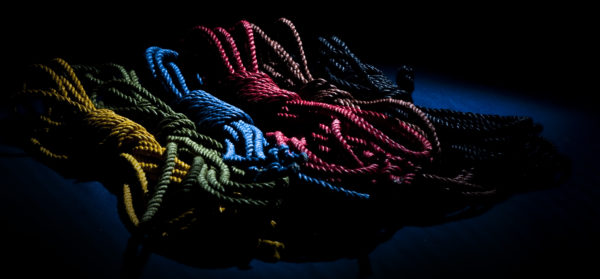How to clean ropes

Ropes can get dirty in two ways: touching the floor or other surfaces and objects or coming into contact with the body of the bottom.
About rope cleaning we should make an important foreword: frequent washing exhaust and reduce the load capacity of the ropes. This means that to prepare some very stiff and rough ropes we can boil them, but then we should avoid washing them further in order not to damage them.
Especially the most delicate ropes (for example Japanese asanawa) are more sensitive to this kind of processing rather than more resistant ones (like hemp or linen ropes).
We could possibly reserve the weakened ropes for floor play.
.
Contact with dirty surfaces
At home we can be sufficiently certain about the cleanliness of floors and furniture and it’s difficult to contract a disease from a rope that has touched some kind of surface; instead when we are outside or in places we don’t know it’s a good practice to lie down a towel, a sheet or a mat where you can play.
If the ropes simply got dusty, we can first wrap them in wide coils and beat them against a clean surface, then clean them briefly rubbing them with a wetted sponge, possibly adding a little bit of disinfectant like sodium hypochlorite.
Instead if the ropes got seriously dirty – with soil or other things – you must wash them in the washing machine at least at 40 °C adding some disinfectant in the recommended dosage.
Pay attention that, as already said, a washing of this kind will weaken the rope.
.
Contact with the body
The story gets complicated when the ropes touch the skin of the bottom and get into contact with bodily fluids.
First of all it’s important to inform the partner of possible transmissible diseases; this will allow us to carry out proper precautions, like to allocate a set of ropes to that specific partner or not to tie directly on bare skin or on intimate areas.
First of all we must consider that getting infected through ropes isn’t that easy and immediate: above all the ropes are usually put on intact skin and this makes contaminations hard to happen through possible pathogenic agents or organic residues that can be present on the ropes. Our body is also able to defend itself from the most common attacks coming from external agents and the ropes aren’t a fertile ground for virus and bacteria so that the majority of them dies in a few days if they don’t find an organism that will host them. Even possible contaminations of some diseases through sweat are really rare.
But there can be a risk of contamination if the ropes are dirtied by vaginal secretions, sperm, excrements or organic residues and then come into contact with mucous membranes (mouth, penis, vagina, anus). Obviously, we are talking about ropes that can be used by different people and not always by the same person.
In this case
- rubbing the rope with a wet disinfectant wipe,
- boiling the rope for a few minutes,
- putting the rope in the oven for a few minutes,
- treating the rope with oil or wax,
- passing the rope over a stove
is useless.
To disinfect a rope you must boil it for at least ten minutes or dip it into a disinfectant solution for long enough or put it in the oven at 150° for two hours or use professional high-temperature machines, but all these treatments would damage the rope itself.
.

A simpler solution
Obviously, all these considerations don’t matter if we do bondage always with the same person.
Instead if we have more than one partner the best solution is to gift the bottom the rope that has been used in intimate areas, and then they can bring it at future sessions. Moreover this “intimate” rope can be washed since it will be allocated to specific usages.
Reserving a personal rope or give the bottom the rope that has been used on intimate areas is an act of respect that will qualify you as a careful and prepared top!
.
.